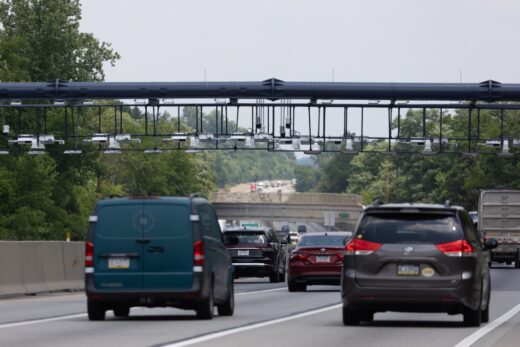everal years after the Pennsylvania Turnpike laid off toll collectors and moved entirely to E-ZPass and toll-by-plate, the system is preparing for another big change.
On Wednesday, the Pennsylvania Turnpike Commission told reporters they’re switching from stop and go tolling to open road tolling starting early next year.
Along the Turnpike near King of Prussia in Montgomery County, officials outlined their plan to move to open road tolling on the Turnpike east of Reading and on the Northeast Extension in January.
The large metal gantries above the Turnpike have been installed over the past year and drawn interest from the public. The gantries have open road tolling equipment installed on them.
Open road tolling allows drivers to pay tolls electronically while traveling at highway speeds, without the need to slow down or stop beneath overhead gantries.
The gantries are equipped with advanced technology to process E-ZPass and Toll-By-Plate transactions.
For the system to work, customers need to ensure their E-ZPass transponders are properly mounted.
“Open road tolling is the most significant innovation for our customers, our employees, our roadway and the commonwealth in our 85-year history,” Turnpike CEO Mark Compton said. “It represents the future of toll collection nation-wide, increases access and mobility across the commonwealth, promotes safety and reliability and better supports our environment.”

The Turnpike’s transition to open road tolling follows the construction of a new fiber optic network spanning the entire mainline route.
Officials said the network not only will work with the tolling system but it also promises to extend high-speed connectivity to neighboring communities.
The removal of toll booths and related infrastructure will eliminate lane switching confusion and increase sight lines, reducing stress and distractions for drivers, officials said.
The Turnpike plans to remove the remaining toll plazas in the eastern sections by 2025, with green spaces taking their place.
Open road tolling construction west of Reading is getting underway, and open road tolling will be fully operational there in early 2027.
By the time all the open road tolling systems open, the Turnpike will have invested more than $600 million into the planning, design, infrastructure, and construction of the new tolling system.

Officials estimate that the open road tolling system will save the Pennsylvania Turnpike Commission at least $25 million annually in maintenance and operating costs.
Turnpike Chief Operating Officer Craig Shuey said that open road tolling will improve safety and lower emissions, because vehicles will no longer need to stop or slow down dramatically at toll booths.
Since the transition to cashless tolling in 2020, there has been a 45 percent reduction in CO2 emissions, equating to approximately 65 tons of CO2 annually. Open road tolling is projected to further reduce CO2 emissions by another 7 percent by 2030, or about 11 tons per year.
The Pennsylvania Turnpike remains the most expensive toll road in the world. Next year, toll rates will increase by 5 percent to continue a trend needed to comply with state laws that diverted revenues to other state transportation projects.









